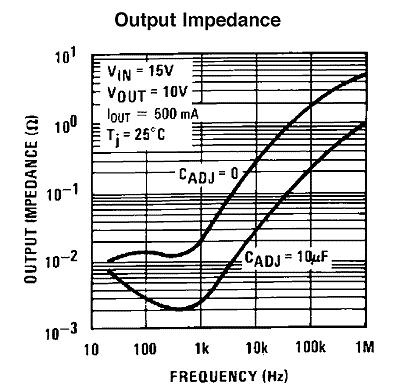
Naim, LM317s and that 27R+47uF filter: just why..?
A quick re-visit to why this filtering combo works so well after LM317 voltage regulators in the context of the Naim-style complementary-feedback pair circuit with it's very low intrinsic 25-30dB PSRR.
First let's take a look at the filtering action of this RC combo: 47uF +27R : -3dB cutoff = 1/(2*pi*27*47e^-6) = 120Hz.
So this filter adds to ripple rejection above this breakpoint. Now look at the ripple rejection graph in the original National Semiconductor datasheet:

Does that make clear the intent..? The 47uf+27R takes-over the ripple rejection exactly at the point where the regulator's rejection starts to drop-off, and it seems this consideration is more important for the Naim implementation than just raw supply impedance. After all, the Complementary Feedback Pair is loaded with a current source, which has very high impedance itself, so perhaps not a complete surprise. The Naim gain/line stages work in Class A and draw (nearly) constant current - in other words the extra 27R in the supply has much less influence over the operatng point of the circuit, than the average DIYer mght expect on first inspection. Thi ssimple filter has the quite elegant function of separating the module doing the power supply, and the modules (circuits) handling amplification - both from the PSU and from each other. Above all its compact, cheap and effective - good engineering IMO.
As an aside - note the other way to get better ripple rejection would be to pull about 300mA from the regulator (graph bottom-left). But that would be horribly inefficient, and still vary with frequency as the graph top-right. So sticking an RC filter after the regulator, while it looks brutal on its own, is actually a very efficient compromise for the Naim circuit. It's compact, easy and cheap, too! Is it the best you can do? Well perhaps not, after all you can play with the RC values (and parts) to yor heart's content in terms of tuning. Another way round would be to ensure the raw supply has as little ripple +noise as possible in the audioband, allowing the use of local 317s without a post filter. I strongly suspect this is one reason Traco DC-DC converters can work so well... But of course there ain't no such thing as a free lunch and so for the best results you have to address the downsides of each chosen approach too - whatever it is.
More to follow...
© the twisted pair 2007